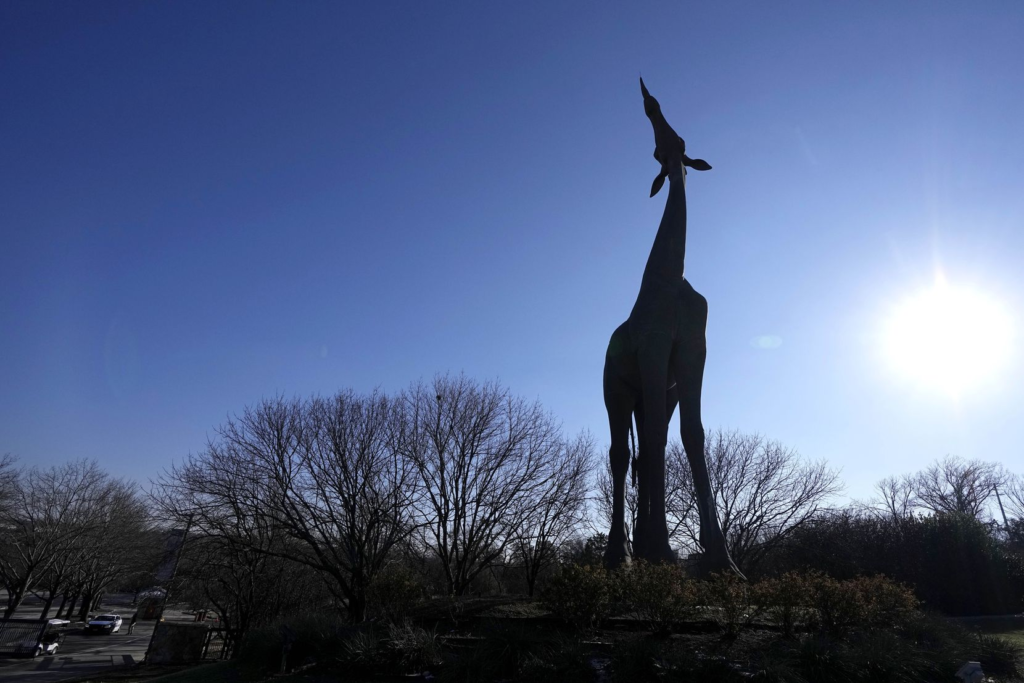Beneath a white-gold moon shadow, a lioness breaks into song. Her call of the wild — a throaty blues — sounds like a cross between a wolf’s yowl and a sea lion’s belch, and the sudden break in the gloaming stillness makes the members of our group jump in unison. Just for a second, we’re on the Serengeti Plain, naked and spearless, and we’re dinner.
Then reality reasserts itself. The mama lion is safely ensconced in a cage without bars, one of those naturalistic habitats with a moat; we’re on asphalt, chuckling self-consciously and surrounded by lush greenery and stands of magnificently gnarled Texas live oak. We can see the lights of nearby skyscrapers sparkling through the branches. No arid African savanna this.
No, we’re on a Night Prowl at the Zoo. It starts in broad, warm daylight, so I wonder why it’s called a Night Prowl as I watch three youngsters swinging like gibbons from a nearby sapling. “Y’all don’t tear up that tree,” drawls their dad, a strapping dude in Banana Republic shorts and chapeau — tourist-safari chic.
There’s nothing like being at a public facility sans the public. The gates are locked, the walkways deserted. It’s just us, the moon and, as twilight approaches, a night breeze that smells like ambrosia.
I find out why dark shades are required for a so-called Night Prowl when I meet my group’s leader, Aaron Brownell, a bright young zookeeper with an earring and a pager. “The animals we’re going to see are crepuscular, which means they’re most active at dawn and dusk,” Brownell explains during an introductory session before we break up into teams. I’m assigned to the middle-school group, which translates to teenagers wearing fashionably baggy jeans. I groan inwardly. I was hoping to tag along with the arboreal tykes I’d encountered earlier — little kids say the darnedest things, and I’m trying to write a slice of animal life; instead, I’m on the tiger beat.
But the teens turn out to be really cool. A couple sulk near the fringes, heads bowed and hands thrust deep in pockets, as we stop to view the giraffes and the cheetahs (the fast cats — a group of five brothers from the same litter — lounge languidly in a heap, like blood princes after a royal feast). Still, most of these kids make sharp observations and ask solid questions about issues like conservation and animal socialization. The latter becomes relevant as we pass an Asian elephant swinging his trunk wildly to and fro. It looks like he’s having fun; he’s not. It’s a mark of depression, we’re told. Elephants are some of the smartest nonhuman creatures on earth; this one’s in prison, and he knows it.
Our 14- and 15-year-olds, too, seem to see the big picture. This is okay, even if they’d rather be hanging out with their friends. Yeah, they’re learning stuff, but it beats homework. The best thing about this deal, though, is that we night prowlers have the Houston Zoo to ourselves. As the teens sense now, and will learn in time, there’s nothing like being at a public facility sans the public. The gates are locked, the walkways (and bathrooms and viewing areas) deserted. It’s just us, the moon and, as twilight approaches, a night breeze that smells like ambrosia.

Well, except around the wolves’ cage, which reeks of sexual musk. The teens grab their noses en masse, make the sort of inane jokes you’d imagine, and zookeep Brownell hurries us along. In short order, we see an acrobatic display of aggressiveness by a monkey called a red-capped mangabey, a glowering, 450-pound Siberian tiger named Rambo, the snout of a shy snow leopard, Texas-specific beasts like the alligator gar and Attwater’s prairie chicken, a newborn llama (many “oohs” and “aahs”), a large rat relation named a capybara (“icks” and “yucks”) and — last stop — a flock of flamingos, their feathers transformed from pale pink to liquid ivory by the silvery shafts of full moonlight.
I stand apart on a bridge, opening my eyes to this painting made real, my ears to the wild call of the birds — a collective skronk that seems to ask, “Who goes there?” Unaccountably, the scene calls to mind Dylan Thomas’s famous poem about old age, but I feel renewed. Rage against the dying of the light? No, I bless these beasts and children and go gentle into the good night.
HOUSTON PRESS MAY 14, 1998